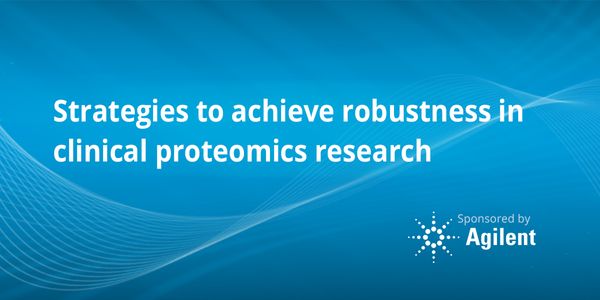Metabolomics
Metabolomics is the scientific study of chemical processes involving metabolites, the small molecule intermediates and products of metabolism.
-
OCT 01, 2020 | 11:00 AMDate: October 1, 2020 Time: 10:00am (PTD), 1:00pm (EDT) Cancer cells rely on altered metabolism to support their proliferation. We performed a CRISPR/Cas9 functional genomic screen targeting...SEP 10, 2020 | 12:00 AMThe microbiome has emerged as a major contributor to human health and disease. Numerous sources implicate shifts in the gut microbiome as potentially pathologic for a variety of autoimmune d...SEP 09, 2020 | 12:00 AMTraditionally, virology has been focused in studying the pathogenic effect of viruses. In the recent years, however, this perception is changing and viruses are being studied as mutualistic...JUL 22, 2020 | 10:00 AMDATE: July 23, 2020 TIME: 10:00 am PDT The SARS-CoV-2 pandemic has taken a toll on many sectors of the medical community. As the pandemic took a grip on the laboratory, the need for diagnost...JUN 30, 2020 | 9:00 AMDATE: June 30, 2020 TIME: 9:00am PDT, 12:00pm EDT QC laboratories perform a critical role in demonstrating pharmaceutical products are consistently manufactured, safe, potent, and pure. At t...JUN 18, 2020 | 8:00 AMAre you interested in Novel Sample Prep and gaining Powerful Insights with Discovery-based LC/MS Workflows? In this session, we will demonstrate a complete untargeted metabolomics workflow f...Speaker: Mark Sartain, PhD , Genevieve Van de Bittner, PhDPresented at: Agilent's Virtual Mass Spectacular!
JUN 17, 2020 | 7:00 AMWe present a novel workflow for native MS, using a robust and sensitive LC/MS method using standard LC flow for native protein analysis. Most of the native MS analyses are using a nano-elect...JUN 16, 2020 | 10:30 AM...Speaker: Steve Pennington, PhD , Clifford C. Dacso, MD , Arun Sreekumar, PhDPresented at: Agilent's Virtual Mass Spectacular!
MAY 28, 2020 | 9:00 AMA recently proposed model for the incorporation of xenobiotics of clinical and forensic interest into the human skeleton suggests nerve agent metabolites may incorporate into bone at relativ...Speaker: Timothy Garrett, PhDMAY 28, 2020 | 7:00 AMThe central carbon metabolism including glycolysis, the pentose phosphate pathway, and the TCA-cycle is essential for all biological systems. The measurements of metabolites involved in thes...Speaker: Kristaps Klavins, PhDMAY 12, 2020 | 9:00 AMNEW DATE: Date: May 12, 2020 Time: 9:00am PDT, 12:00pm EDT...MAY 06, 2020 | 1:00 PMThe forensic investigation of crime involves answering four basic questions: who, what, where, and when. Tools exist to answer questions of who, what and where, but the question when is ofte...MAY 06, 2020 | 9:00 AMCrime scene investigation is more than just processing or documentation of crime scenes, nor is it just the collection or packaging of physical evidence. It is the first step and the most cr...MAY 06, 2020 | 7:30 AMThe toxicology of particulate matter is complicated by characteristics not normally encountered when addressing poisonings associated with chemical substances. Particle shape, surface reacti...MAY 06, 2020 | 12:00 AMThe current standard methodology in forensic DNA typing relies on amplification of short tandem repeat (STR) markers by the polymerase chain reaction (PCR) and allele sizes (i.e., length-bas...MAY 06, 2020 | 12:00 AMIn late 2019, nearly a decade into a life sentence, Lydell Grant was released from a Texas prison after being convicted of a murder that he did not commit. The victim, Aaron Scheerhorn, was...MAY 06, 2020 | 12:00 AMLearning Objectives: 1. Molecular basis of microhaplotypes 2. Informativeness and power of discrimination of microhaplotypes 3. Mixture deconvolution via microhaplotypes...MAY 06, 2020 | 12:00 AMThe potential for cognitive bias in forensic evidence interpretation and crime scene investigation continues to receive attention and debate within forensic and academic communities. Startin...MAY 06, 2020 | 12:00 AMHydroxychloroquine and chloroquine are long-standing antimalarial drugs recently brought into the spotlight as potential treatments for the pandemic-causing coronavirus (SARS-CoV-2). Notable...MAY 06, 2020 | 12:00 AMThe ever-increasing number of deaths along the U.S.-México border and the diversification in the demographic characteristics of the Latin American migrants, who perish in this region,...MAY 06, 2020 | 12:00 AMThe necrobiome is the community of organisms that use or are affected by decomposing organic matter. Decomposing organic matter comes in the form of dead plant matter (biomass) or that of de...APR 29, 2020 | 6:00 AM...APR 23, 2020 | 9:00 AMLearning Objectives: 1. What is wrong with healthcare today 2. What kinds of omics and wearables data can be used to best predict disease risk and manage health...APR 09, 2020 | 8:00 AMDATE: April 9, 2020 TIME: 8:00am PT, 11:00am ET Mass spectrometry-based proteomics allows the simultaneous measurement of a large number of proteins...
OCT 01, 2020 | 11:00 AM
Date: October 1, 2020 Time: 10:00am (PTD), 1:00pm (EDT) Cancer cells rely on altered metabolism to support their proliferation. We performed a CRISPR/Cas9 functional genomic screen targeting...
SEP 10, 2020 | 12:00 AM
The microbiome has emerged as a major contributor to human health and disease. Numerous sources implicate shifts in the gut microbiome as potentially pathologic for a variety of autoimmune d...
SEP 09, 2020 | 12:00 AM
Traditionally, virology has been focused in studying the pathogenic effect of viruses. In the recent years, however, this perception is changing and viruses are being studied as mutualistic...
JUL 22, 2020 | 10:00 AM
DATE: July 23, 2020 TIME: 10:00 am PDT The SARS-CoV-2 pandemic has taken a toll on many sectors of the medical community. As the pandemic took a grip on the laboratory, the need for diagnost...
JUN 30, 2020 | 9:00 AM
DATE: June 30, 2020 TIME: 9:00am PDT, 12:00pm EDT QC laboratories perform a critical role in demonstrating pharmaceutical products are consistently manufactured, safe, potent, and pure. At t...
JUN 18, 2020 | 8:00 AM
Are you interested in Novel Sample Prep and gaining Powerful Insights with Discovery-based LC/MS Workflows? In this session, we will demonstrate a complete untargeted metabolomics workflow f...
Speaker:
Mark Sartain, PhD
, Genevieve Van de Bittner, PhD
Presented at: Agilent's Virtual Mass Spectacular!
JUN 17, 2020 | 7:00 AM
We present a novel workflow for native MS, using a robust and sensitive LC/MS method using standard LC flow for native protein analysis. Most of the native MS analyses are using a nano-elect...
JUN 16, 2020 | 10:30 AM
...
Speaker:
Steve Pennington, PhD
, Clifford C. Dacso, MD
, Arun Sreekumar, PhD
Presented at: Agilent's Virtual Mass Spectacular!
MAY 28, 2020 | 9:00 AM
A recently proposed model for the incorporation of xenobiotics of clinical and forensic interest into the human skeleton suggests nerve agent metabolites may incorporate into bone at relativ...
Speaker:
Timothy Garrett, PhD
MAY 28, 2020 | 7:00 AM
The central carbon metabolism including glycolysis, the pentose phosphate pathway, and the TCA-cycle is essential for all biological systems. The measurements of metabolites involved in thes...
Speaker:
Kristaps Klavins, PhD
MAY 12, 2020 | 9:00 AM
NEW DATE: Date: May 12, 2020 Time: 9:00am PDT, 12:00pm EDT...
MAY 06, 2020 | 1:00 PM
The forensic investigation of crime involves answering four basic questions: who, what, where, and when. Tools exist to answer questions of who, what and where, but the question when is ofte...
MAY 06, 2020 | 9:00 AM
Crime scene investigation is more than just processing or documentation of crime scenes, nor is it just the collection or packaging of physical evidence. It is the first step and the most cr...
MAY 06, 2020 | 7:30 AM
The toxicology of particulate matter is complicated by characteristics not normally encountered when addressing poisonings associated with chemical substances. Particle shape, surface reacti...
MAY 06, 2020 | 12:00 AM
The current standard methodology in forensic DNA typing relies on amplification of short tandem repeat (STR) markers by the polymerase chain reaction (PCR) and allele sizes (i.e., length-bas...
MAY 06, 2020 | 12:00 AM
In late 2019, nearly a decade into a life sentence, Lydell Grant was released from a Texas prison after being convicted of a murder that he did not commit. The victim, Aaron Scheerhorn, was...
MAY 06, 2020 | 12:00 AM
Learning Objectives: 1. Molecular basis of microhaplotypes 2. Informativeness and power of discrimination of microhaplotypes 3. Mixture deconvolution via microhaplotypes...
MAY 06, 2020 | 12:00 AM
The potential for cognitive bias in forensic evidence interpretation and crime scene investigation continues to receive attention and debate within forensic and academic communities. Startin...
MAY 06, 2020 | 12:00 AM
Hydroxychloroquine and chloroquine are long-standing antimalarial drugs recently brought into the spotlight as potential treatments for the pandemic-causing coronavirus (SARS-CoV-2). Notable...
MAY 06, 2020 | 12:00 AM
The ever-increasing number of deaths along the U.S.-México border and the diversification in the demographic characteristics of the Latin American migrants, who perish in this region,...
MAY 06, 2020 | 12:00 AM
The necrobiome is the community of organisms that use or are affected by decomposing organic matter. Decomposing organic matter comes in the form of dead plant matter (biomass) or that of de...
APR 29, 2020 | 6:00 AM
...
APR 23, 2020 | 9:00 AM
Learning Objectives: 1. What is wrong with healthcare today 2. What kinds of omics and wearables data can be used to best predict disease risk and manage health...
APR 09, 2020 | 8:00 AM
DATE: April 9, 2020 TIME: 8:00am PT, 11:00am ET Mass spectrometry-based proteomics allows the simultaneous measurement of a large number of proteins...























